Key takeaways:
- Engagement in learning is significantly enhanced when learners can relate content to personal experiences and participate actively in problem-solving.
- Interactive programming tutorials build a sense of community and provide instant feedback, which is crucial for motivation and understanding.
- Effective tutorials rely on clear instructions, real-world examples, and varied formats to maintain learner interest and reinforce knowledge.
- Creating a supportive learning environment fosters collaborative experiences and deeper understanding among learners.
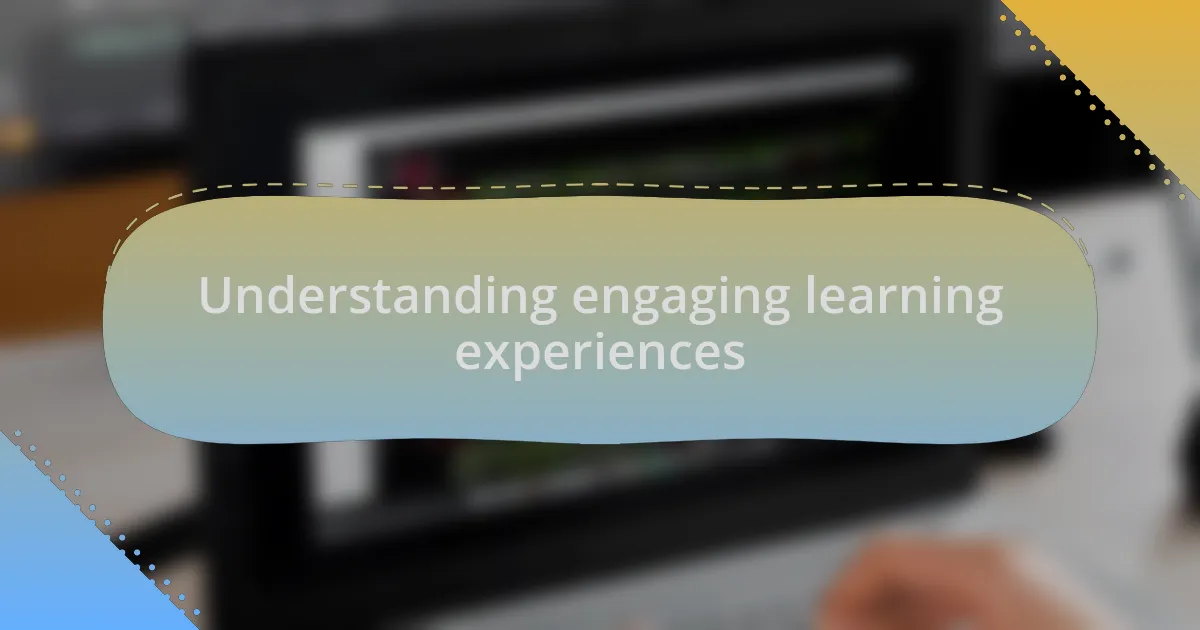
Understanding engaging learning experiences
Engaging learning experiences hinge on the connection between the learner and the material. I remember a time when I was struggling with a complex coding concept. It wasn’t until a mentor related the idea to a personal project of mine that I truly grasped it. That moment underscored for me how critical relatability is in learning; when learners can see themselves in the content, they’re more likely to connect with it.
Think about your own best learning moments. Were they filled with passive reading, or were they vibrant, interactive, and perhaps even a bit challenging? I find that when I am actively involved—whether it’s through coding challenges or collaborative projects—I’m more invested and eager to succeed. This dynamic of interaction fosters a deeper understanding and retention of knowledge, making the experience richer.
Moreover, emotional engagement plays a stellar role in retention. I’ve often noticed that when learners are excited or even a bit frustrated, they tend to remember those experiences longer. It’s fascinating how emotions can anchor learning in such profound ways, prompting me to always think about how I can add layers of excitement or even a bit of challenge to my tutorials. After all, isn’t the thrill of overcoming a coding obstacle what keeps many of us coming back to learn more?
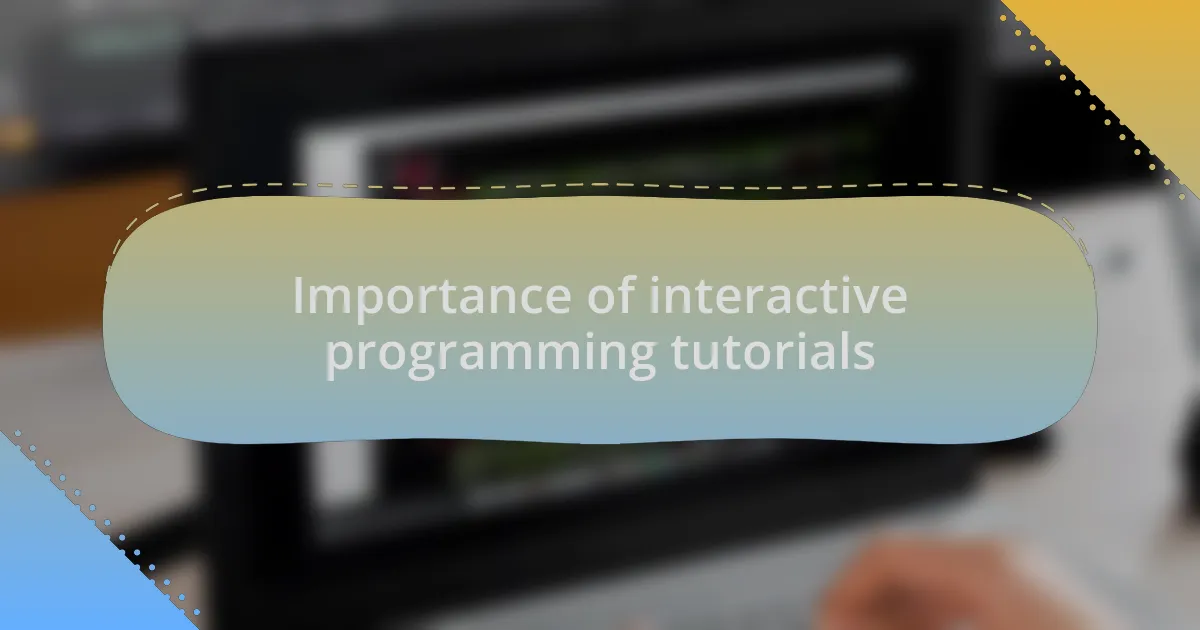
Importance of interactive programming tutorials
Interactive programming tutorials are essential because they actively involve learners in the problem-solving process. I recall the first time I used a simulated coding environment; it felt like I was genuinely writing real code, not just following along. This hands-on experience helped me see where I could apply my skills immediately, making it more relatable and memorable compared to traditional learning methods.
Moreover, these tutorials foster a sense of community among learners. I remember participating in an online coding challenge where we had to solve problems in groups. The collaborative aspect allowed me to learn from others and see different approaches to the same problem. Isn’t it amazing how sharing ideas can spark deeper understanding and creativity? Interactivity not only enriches knowledge but also builds camaraderie among peers, creating an environment where everyone feels they belong.
Another critical factor is the instant feedback that comes with interactive elements. I can’t emphasize enough how rewarding it was to receive immediate responses on my coding mistakes. That real-time feedback loop helped me adjust my thought processes and improve rapidly. Have you ever had that “aha” moment when correcting an error? It’s pure gold in the learning experience, making every step feel like progress and keeping motivation high.
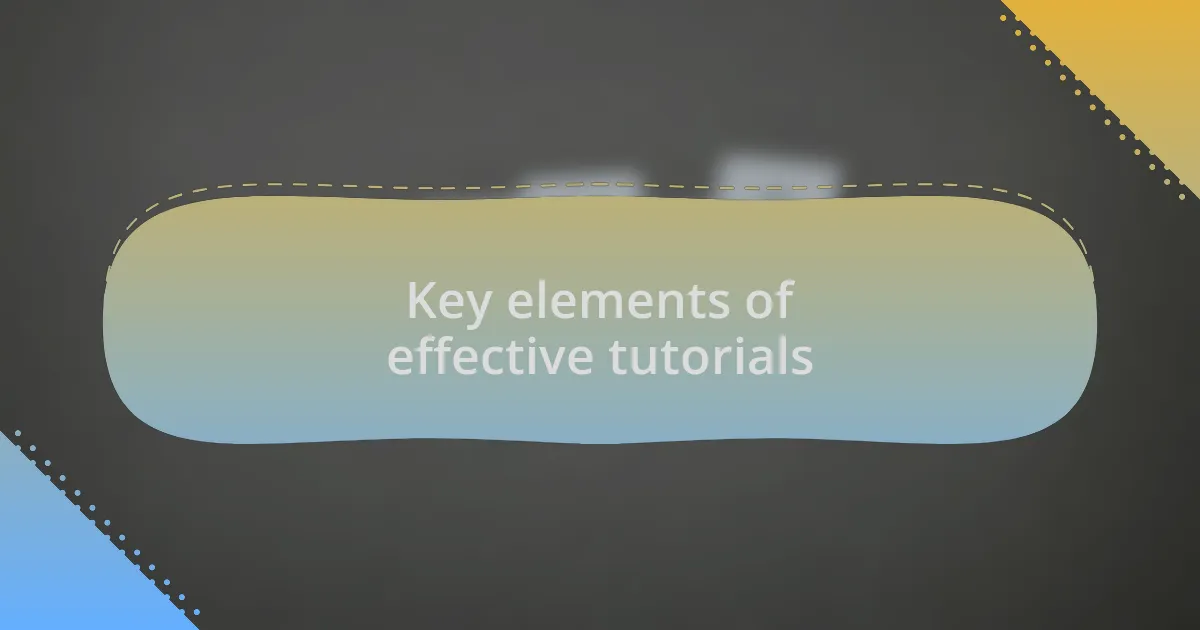
Key elements of effective tutorials
Effective tutorials are built on several key elements that enhance learning. One of the most crucial is clarity in instruction. I remember struggling with complex programming jargon early on; it often hindered my understanding. When a tutorial breaks down concepts into understandable chunks, it feels like a guiding hand leading me through a maze rather than just throwing me into the deep end. It’s vital that each step is articulated clearly, making the learning journey feel less daunting.
Another important element is the use of real-world examples. This approach resonates deeply with me because I learn best when I can connect abstract concepts to practical applications. I once went through a tutorial that showed how a simple algorithm could optimize a website’s loading time. That was a “lightbulb moment” for me, as I could immediately envision how to apply that knowledge in a real project. Doesn’t it feel rewarding to see your skills translate into something tangible and useful?
Lastly, engagement is key, and utilizing varied formats like quizzes or coding challenges can keep the learner’s interest piqued. While I was navigating a particularly challenging course, I found that short quizzes helped reinforce what I had learned. They acted as check-ins for my understanding and provided a sense of accomplishment. Have you noticed how small victories contribute to maintaining motivation? Each successful completion builds momentum, propelling me forward on my learning path.
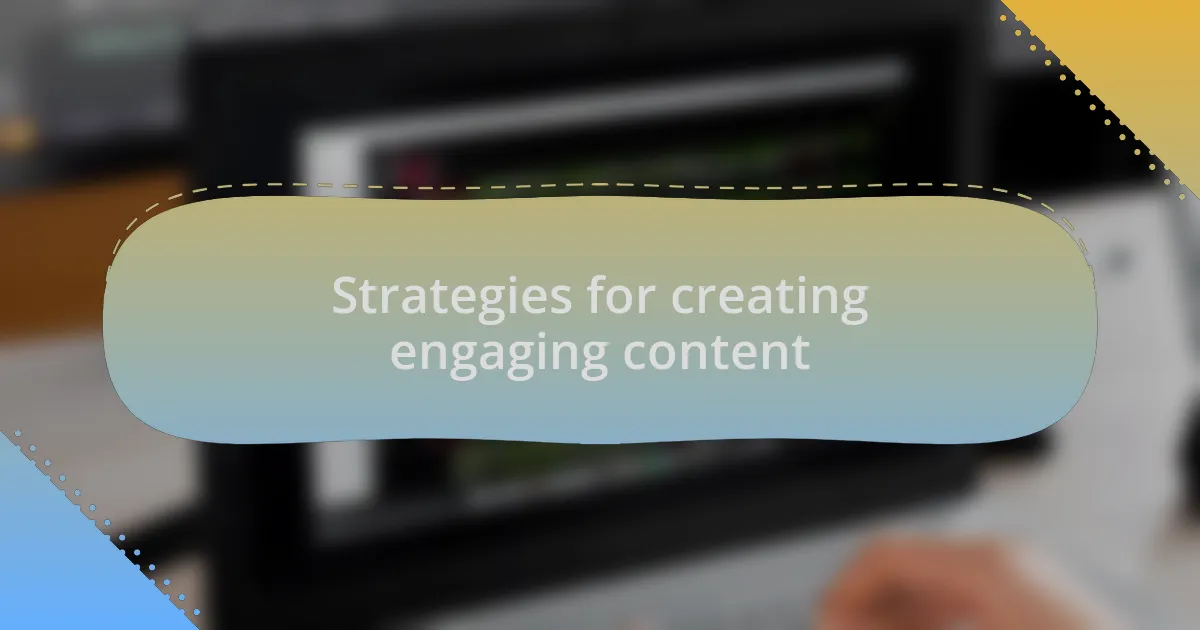
Strategies for creating engaging content
Creating engaging content really hinges on incorporating interactive elements into tutorials. I remember one instance where a tutorial included a sandbox environment—allowing me to experiment with code in real-time. It transformed a passive learning experience into an active one, making the content come alive before my eyes. Have you ever felt the thrill of seeing your code work instantly? That immediate feedback is exhilarating and reinforces learning like nothing else.
Visual aids also play a crucial role in enhancing engagement. I once followed a programming guide that used well-placed diagrams to map out complex algorithms. The combination of visuals and text didn’t just help clarify the concepts but also made the entire learning experience visually appealing. Don’t you find that sometimes a picture is worth a thousand words? The visuals made the content more memorable and allowed me to grasp difficult ideas with ease.
Another effective strategy is to encourage community interaction. When I participated in a forum discussion related to a tutorial, not only did I gain diverse perspectives, but I also found a sense of belonging in the learning process. Engaging with others who share the same challenges and victories made my journey much more fulfilling. Have you ever reflected on how sharing experiences with others enhances your understanding? Collaboration can turn isolated learning into a shared adventure, creating bonds that resonate beyond the screen.
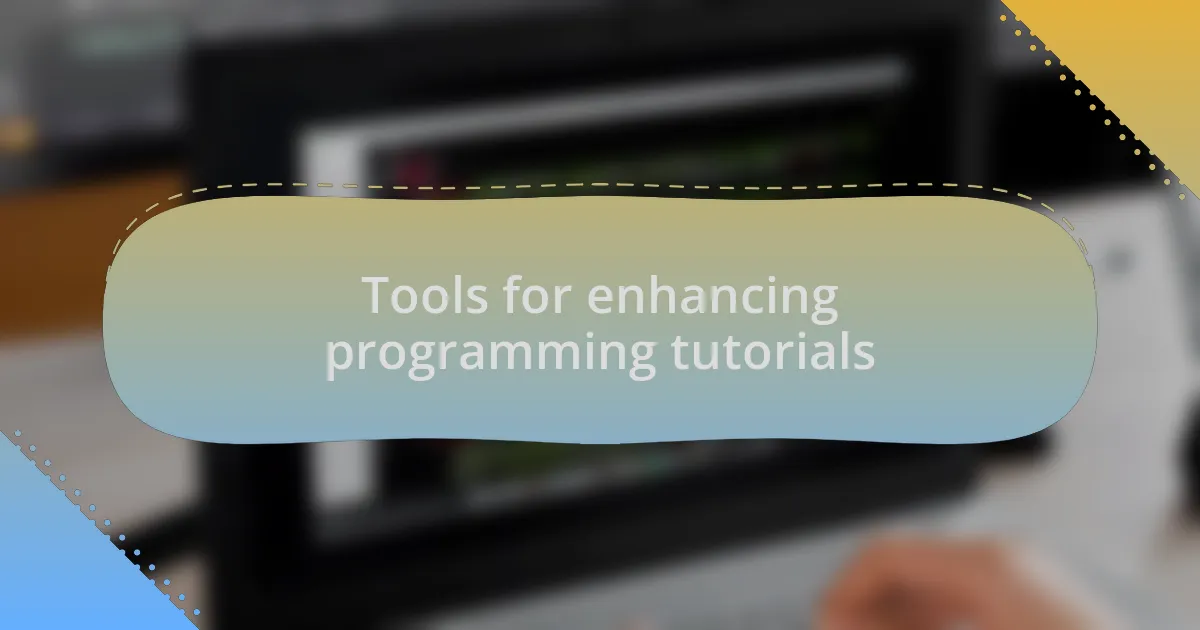
Tools for enhancing programming tutorials
When it comes to enhancing programming tutorials, integrating tools like code editors with built-in collaboration features can make a significant difference. I once used an online code editor that allowed real-time collaboration with others. It was fascinating to see someone else’s code unfold on my screen as we worked through a problem together. Have you ever tried coding alongside someone in a shared environment? That sense of teamwork not only enriched my learning but also fostered a deeper understanding of problem-solving.
Another invaluable tool is the use of video demonstrations. I vividly recall watching a series of screencasts where the instructor walked through coding concepts step-by-step. It felt as though I was right there with them, learning their thought process and picking up tips that wouldn’t be apparent from mere text. Do you find yourself more engaged when you can watch someone navigate through a coding challenge? This visual storytelling brings the material to life and makes it much easier to absorb complex ideas.
Finally, implementing coding quizzes and challenges at the end of each tutorial can help consolidate learning. I remember completing a challenging quiz after some tutorials, and while it was tough, it felt rewarding to apply what I had just learned. Have you ever experienced that rush after solving a particularly tricky problem? Those quizzes not only reinforce knowledge but also build confidence as you see your skills evolve over time, making the entire learning experience more interactive and dynamic.
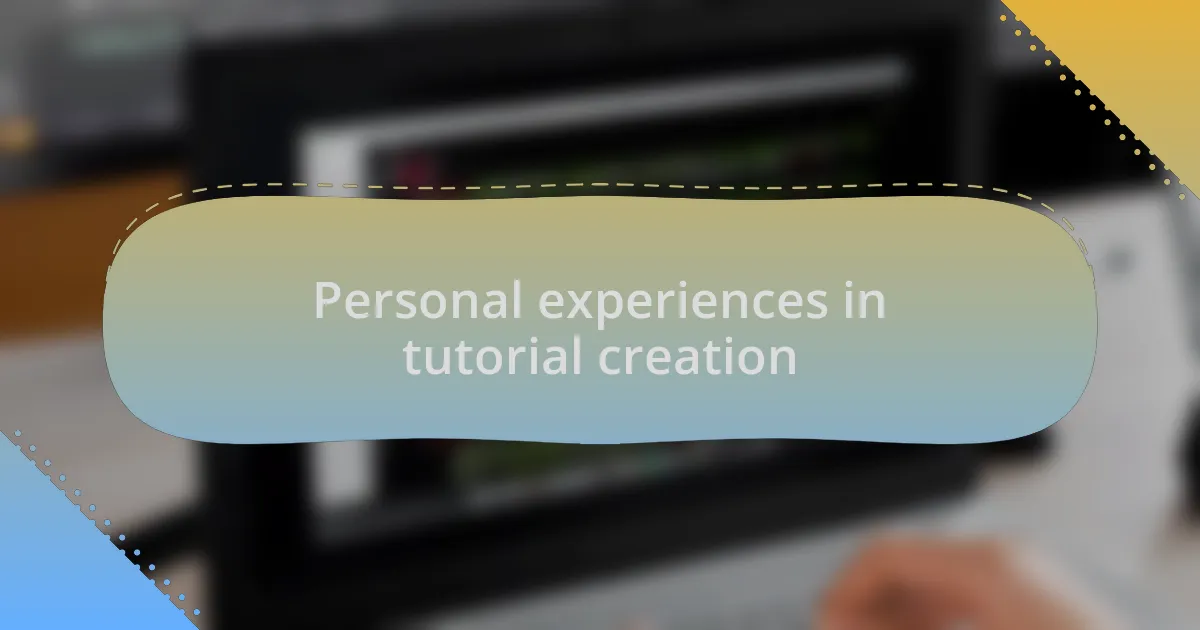
Personal experiences in tutorial creation
Creating my tutorials has been a journey of discovery and growth. Early on, I remember experimenting with step-by-step coding challenges, crafting them like a puzzle. This approach not only helped my learners engage more deeply but also allowed me to explore my understanding of the material. Have you ever created a challenge only to realize how much you learned in the process?
I also learned the importance of feedback during my tutorial creation. After launching my first few videos, I received comments that offered perspectives I hadn’t considered. Feedback from users can be a goldmine; it highlights what works and reveals areas for improvement. I often think back to that instance when a viewer pointed out a clearer explanation I could have provided. Isn’t it incredible how a simple suggestion can lead to a more effective tutorial?
One memorable experience was when I hosted a live coding session, where learners could ask questions in real-time. The energy was electric, and I loved the way participants fed off each other’s curiosity. I remember a moment when a student asked a question that made us all rethink the problem. That interaction taught me that learning is not just about delivering knowledge; it’s about creating a space for exploration. How do you feel about engaging in discussions while learning? Those moments of connection can turn a tutorial into an unforgettable experience.
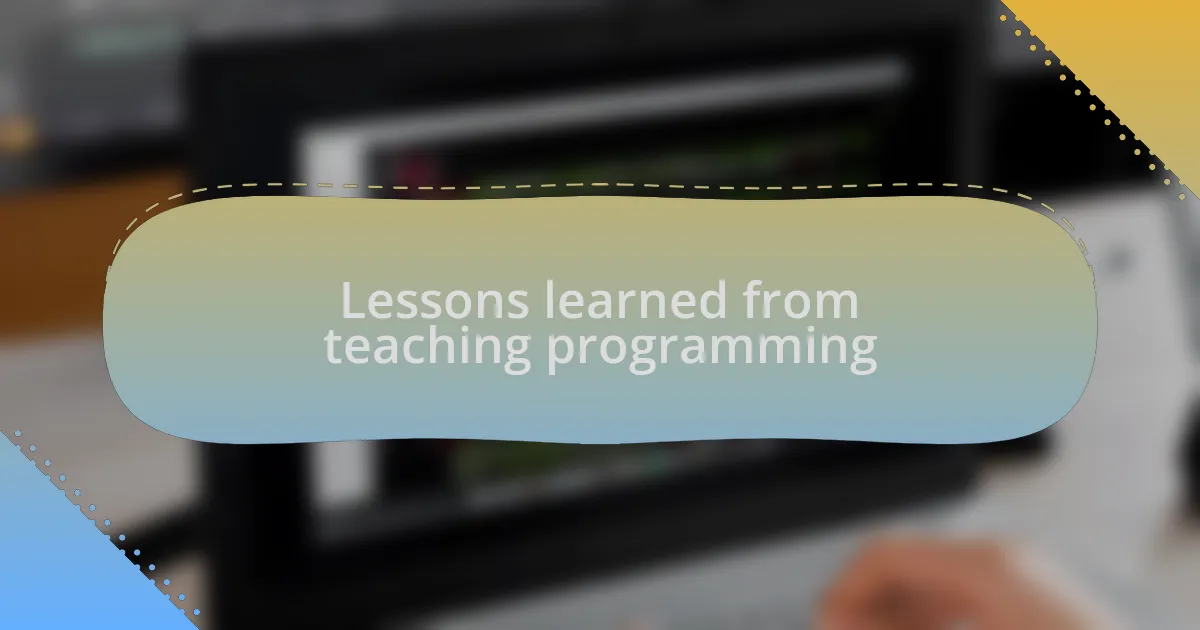
Lessons learned from teaching programming
Teaching programming has unveiled some surprising lessons for me, particularly the value of simplicity. During one tutorial, I decided to break down a complex algorithm into bite-sized parts. Watching my students’ faces light up as they grasped each segment was profoundly rewarding. Have you ever witnessed that “aha!” moment? It’s a reminder that clarity often trumps complexity.
Another insightful experience came when I introduced pair programming in my sessions. I paired students to solve problems collaboratively, and the results were striking. They engaged in discussions, challenged each other, and built confidence. I realized then that sharing learning experiences can enhance understanding far more than solitary study. Isn’t it fascinating how collaboration fosters growth?
One of the most enlightening aspects of teaching programming has been learning to adapt to different learning paces. I recall a session where I had to pivot mid-lesson as some students were losing interest while others were hungry for more. Adjusting my approach on the fly taught me the importance of flexibility in teaching. Have you ever had to navigate such diverse learning needs? It’s an ongoing challenge, yet it encourages me to become a more dynamic educator.